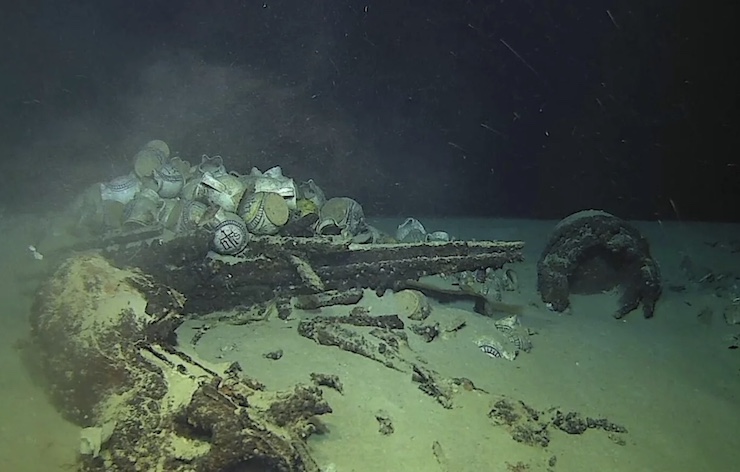Underwater Drones Help Discover France’s Deepest Shipwreck

© National Navy via France’s Department of Underwater and Submarine Archaeological Research
Roughly 71% of Earth’s surface is covered by water, yet much of it remains unexplored, especially its deeper regions, which average around 3,700 meters in depth but can range from just a few meters in coastal zones to over 11,000 meters in the Mariana Trench. Beneath these vast waters lie an estimated 3 million shipwrecks, spanning thousands of years of maritime history. Of those, only a fraction, fewer than 20,000, have been located and documented. In the past decade, however, that number has begun to climb steadily, thanks in large part to advances in underwater drone technology. Autonomous and remotely operated vehicles (AUVs and ROVs) have made it possible to survey deeper, faster, and more accurately than ever before, unlocking secrets long hidden on the ocean floor.
One of the earliest and most high-profile shipwrecks discovered with the help of drone technology was the HMS Erebus, a vessel from Sir John Franklin’s doomed 1845 Arctic expedition. Located in 2014 by a Canadian team using an autonomous underwater vehicle, the find marked a turning point in underwater archaeology. Since then, drones have played a key role in uncovering other historic wrecks in some of the world’s most challenging environments.
In 2022, the Endurance, lost in Antarctica’s Weddell Sea during Ernest Shackleton’s expedition, was found nearly 3,000 meters below the ice using a hybrid submersible called Sabertooth. In 2020, the USS Nevada, a battleship that survived both Pearl Harbor and nuclear testing, was located more than 4,700 meters deep off Hawaii by a team using autonomous and remotely operated drones. And in 2023, the Montevideo Maru, a World War II transport ship carrying over 1,000 prisoners of war, was found off the Philippines with the help of deep-sea drone mapping. These discoveries, once thought impossible, are now becoming routine as technology continues to push the boundaries of ocean exploration.
While many shipwrecks are found through targeted search missions, others are discovered entirely by accident during unrelated underwater operations. The recent finding of France’s deepest known shipwreck is a prime example. Recently, a French Navy team conducting a routine drone seabed survey off Saint-Tropez stumbled upon a 16th-century merchant vessel more than 2,500 meters below the surface. The operation was not intended to locate historical wrecks but to support a military exercise focused on deep-sea monitoring. As deputy maritime prefect, Major General Thierry de la Burgade recounted, “The sonar detected something quite big, so we went back with the device’s camera, then again with an underwater robot to snap high-quality images.”
That marked the initial astonishing discovery of what would be named Camarat 4, France’s deepest known wreck. To investigate further, France’s Ministry of Culture body, DRASSM (Department of Underwater and Submarine Archaeological Research), deployed a ROV to survey the site in detail. This vessel was identified as a 98-foot-long, 23-foot-wide 16th-century merchant ship, believed to have originated in Liguria in northwest Italy, and transporting around 200 decorative ceramic pitchers, 100 plates, metal bars, two cauldrons, six cannons, and an anchor.
At 2,567 meters, it is the deepest wreck ever recorded in French waters, and its remote location has protected it from looting and degradation. “Camarat 4 is a remarkable discovery for its depth, unprecedented character and the opportunity it offers to study an almost intact 16th-century wreck,” explained Marine Sadania, who specializes in underwater archaeology with DRASSM. Sadania considers the wreck a priceless time capsule because of its intact cargo and unique insights into Mediterranean trade. She said the team plans to digitize the wreck using drone-enabled 3D photogrammetry over the next two years and selectively recover a few artifacts, such as a ceramic jug or metal bar, using the drone’s robotic arm. These will be carefully studied and then returned for public display.
Major General de la Burgade emphasized how drones are redefining underwater discovery, saying, “An underwater drone stumbled upon the sunken ship by chance,” marking a new era where military and environmental drone usage can yield unexpected archaeological breakthroughs. As underwater drones become more widely used for everything from infrastructure inspections to ecological studies, these unintentional discoveries are becoming increasingly common. Each surprise find not only expands our understanding of maritime history but also demonstrates the growing reach of autonomous and remotely operated technologies across the ocean floor.
|